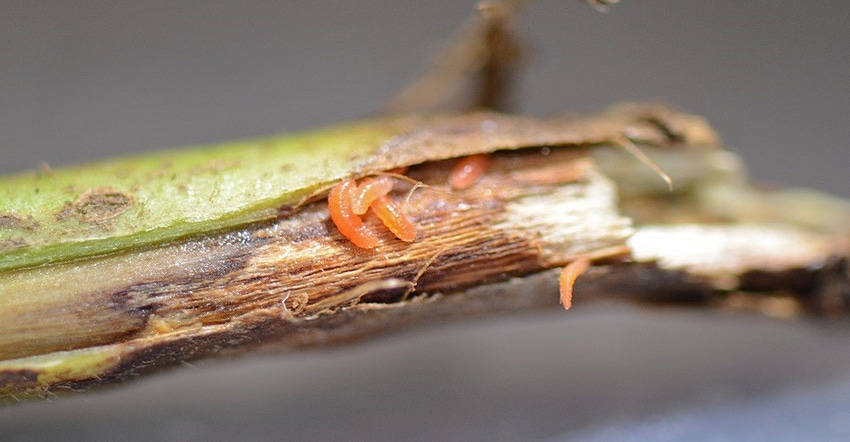July 5, 2019

A soybean pest found in Minnesota fields last year in McLeod and Rock counties, successfully overwintered and was found again last month.
Bruce Potter, University of Minnesota Extension Integrated Pest Management specialist in Lamberton, and Bob Koch, Extension entomologist in St. Paul, first wrote about orange gall midge last summer, reporting that the pest had injured some soybean fields.
The two scientists reported in a recent online Extension crop news post that soybean gall midges were found in mid-June in a Rock County field. The midges were found in emergence cages, which had been placed in the field as part of a multistate research project funded by the soybean checkoff. This was the same field were midge was found in 2018. Other cages were set in Olmsted, Stearns, Ottertail and Wadena counties, but no adult midges had been detected as of June 26.
“This research confirms that this newly described insect, Resselliella maxima, was able to overwinter in our soils, presumably pupating this spring, and emerge as adults,” they wrote. “It also appears that the emergence pattern of soybean gall midge is roughly following the progression of degree-day accumulations from south to north.”
The scientists said that the Minnesota captures rates are low when compared to some fields in nearby states that had heavy infestations in 2018. However, not all heavily infested fields located outside Minnesota have produced large captures in emergence cages this year, they added.
Potter and Koch said it is unlikely farmers will see midges in their soybean fields or in sweep net samples.
“Soybean gall midge adults are tiny. Excluding the long legs, the bodies of the specimens we have captured are less than 1/8 inch long,” they wrote. “Their slender bodies are smaller than the gnats that plagued much of southern Minnesota this spring. If you do suspect a soybean gall midge adult, look for the very small size, reddish abdomen, and light and dark banding on the legs.”
At this time, insecticide use for soybean gall midge is not recommended in Minnesota. Scientists are conducting a small insecticide experiment in soybeans adjacent to the field with observed midge emergence.
As adult emergence declines, scientists will shift research efforts to determine the number of gall midge generations produced per year and to identify soybean plants with symptoms of infestation. Potter and Koch would like farmers to help with that by contacting them and sharing their observations. Contact them via email at [email protected] or [email protected].
Source: Minnesota Crop News, which is solely responsible for the information provided and is wholly owned by the source. Informa Business Media and all its subsidiaries are not responsible for any of the content contained in this information asset.
You May Also Like




